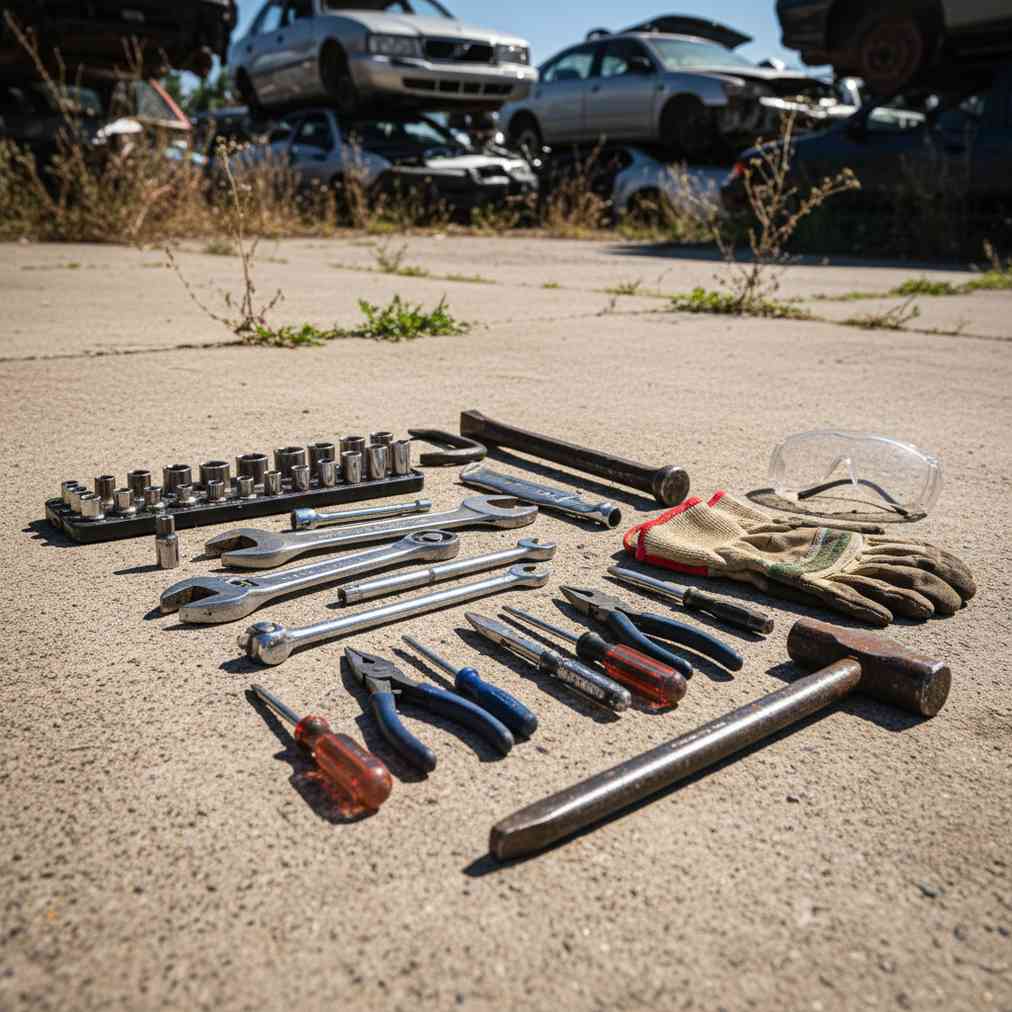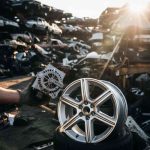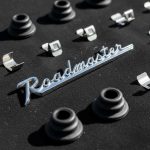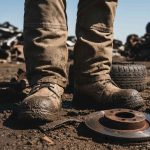Why Proper Tools Make All the Difference at U-Pull-It Junkyards
Walking into a U-Pull-It junkyard without the right tools is like going fishing without bait – you might get lucky, but you’re setting yourself up for frustration. Whether you’re a seasoned mechanic or a weekend DIY enthusiast, having the proper equipment can transform your salvage yard experience from a sweaty struggle into an efficient parts-gathering mission.
The key to success lies in preparation. Expert salvage yard operators consistently emphasize that well-equipped visitors not only save time but also avoid the disappointment of finding the perfect part only to discover they can’t remove it safely.
The Top 12 Essential Tools for U-Pull-It Success
After consulting with industry experts and seasoned junkyard veterans, we’ve compiled the definitive list of tools that will maximize your chances of success while keeping you safe and efficient.
1. Comprehensive Socket Set (SAE and Metric)
A complete socket set is absolutely crucial since vehicles use a mix of both standard (SAE) and metric fasteners. Your kit should include:
- Multiple drive sizes (1/4″, 3/8″, and 1/2″)
- Extensions for reaching difficult bolts
- Universal joints for awkward angles
- Deep and shallow sockets for various applications
Professional mechanics recommend investing in quality sockets that won’t round off under pressure, especially when dealing with rusty or overtightened fasteners common in salvage yards.
2. Complete Wrench Set (SAE and Metric)
Combination wrenches with both box and open ends are essential for holding nuts while loosening bolts. Junkyard tool experts suggest bringing a complete set ranging from 6mm to 19mm and 1/4″ to 3/4″ to cover most automotive applications.
3. High-Quality Ratchet
A reliable ratchet, preferably with a 1/2-inch drive for larger bolts, will significantly speed up your removal process. Look for ratchets with:
- Fine tooth count for working in tight spaces
- Comfortable grip for extended use
- Quick-release mechanism for socket changes
4. Breaker Bar for Stubborn Fasteners
When dealing with rusted or overtightened bolts, a breaker bar provides the extra leverage needed without risking damage to your ratchet. This tool is particularly valuable for suspension components and engine mounts that have been torqued to high specifications.
5. Versatile Pry Bar Set
Pry bars are indispensable for:
- Separating stuck components
- Creating working space around parts
- Gently persuading stubborn assemblies
- Removing trim pieces and interior components
6. Dead Blow Hammer
A dead blow hammer provides controlled impact without bouncing, making it perfect for freeing seized parts or gently tapping components into alignment. The sand-filled head reduces damage to delicate surfaces while delivering effective force.
7. Complete Screwdriver Set
Interior trim, electrical components, and various automotive fasteners require a comprehensive screwdriver collection including:
- Flathead screwdrivers (multiple sizes)
- Phillips head screwdrivers
- Torx bits for modern vehicles
- Magnetic tips for small screws
8. Specialized Pliers Collection
Different types of pliers serve specific purposes in salvage yard work:
| Plier Type | Primary Use |
|---|---|
| Needle-nose | Tight spaces, small components |
| Locking pliers (Vise-Grips) | Holding rounded fasteners |
| Wire cutters | Cutting harnesses and cables |
| Diagonal cutters | Precision wire work |
9. Heavy-Duty Work Gloves
Hand protection is non-negotiable in salvage yards. Bring both:
- Durable mechanic’s gloves for general work
- Disposable nitrile gloves for handling fluids
- Cut-resistant gloves for sharp metal edges
10. ANSI-Rated Safety Glasses
Eye protection is essential when working underneath vehicles or dealing with flying debris. Choose safety glasses with side shields and anti-fog coating for maximum protection and visibility.
11. Powerful LED Flashlight or Headlamp
Good lighting is crucial for identifying parts and working safely in dark engine bays or undercarriages. Experienced salvage yard visitors prefer hands-free LED headlamps for maximum convenience.
12. Penetrating Oil (WD-40 or PB Blaster)
A quality penetrating oil can work miracles on rusted bolts. Apply it early in your visit to give it time to work while you assess other parts. PB Blaster is particularly effective on severely corroded fasteners.
Bonus Tools That Professionals Swear By
While not essential, these additional tools can significantly enhance your junkyard experience:
- Cordless impact driver – Dramatically speeds up fastener removal
- Small tarp – Provides clean workspace and protects parts
- Magnetic parts tray – Keeps small fasteners organized
- Digital camera – Document part placement for reassembly
- Measuring tape – Verify part dimensions before removal
The Compelling Case for Used Auto Parts
Understanding the benefits of purchasing used auto parts helps justify the time and effort invested in proper junkyard preparation. The advantages extend far beyond simple cost savings.
Significant Cost Savings
Used auto parts typically cost 50-70% less than new equivalents, making vehicle repairs more accessible to budget-conscious consumers. For expensive components like transmissions or fuel pumps, these savings can amount to thousands of dollars.
Environmental Responsibility
Purchasing used parts is an eco-conscious choice that:
- Reduces demand for new manufacturing
- Conserves raw materials and energy
- Diverts usable components from landfills
- Promotes circular economy principles
Availability of Rare Components
Salvage yards often stock discontinued parts that are no longer available through traditional channels, making them invaluable resources for classic car restoration and older vehicle maintenance.
Professional Part Inspection Guidelines
Proper inspection techniques separate successful junkyard visitors from disappointed ones. Follow this systematic approach to evaluate potential purchases:
Visual Inspection Checklist
| Inspection Point | What to Look For | Red Flags |
|---|---|---|
| Physical Damage | Intact mounting points | Cracks, dents, bent components |
| Corrosion | Surface rust only | Deep rust, structural weakening |
| Wear Patterns | Normal use evidence | Excessive wear, scored surfaces |
| Completeness | All necessary hardware | Missing bolts, connectors |
Functional Testing Strategies
When possible, assess the operational condition of moving parts:
- Electrical components – Check connector condition and pin integrity
- Mechanical parts – Test for smooth operation and proper movement
- Engine components – Look for oil leaks, unusual wear patterns
- Seals and gaskets – Inspect for cracking or hardening
Compatibility Verification
Ensuring part compatibility prevents costly mistakes. Salvage yard professionals recommend bringing detailed vehicle specifications including VIN, engine code, and transmission type to verify exact matches.
Safety First: Essential Protective Equipment
Junkyard safety cannot be overstated. The right protective equipment prevents injuries and ensures an enjoyable experience:
- Steel-toed boots – Protection from falling objects and sharp debris
- Long pants – Shield legs from cuts and chemical exposure
- Protective eyewear – Guard against flying particles and fluids
- First aid kit – Basic wound care for minor cuts and scrapes
Maximizing Your Junkyard Investment
Smart junkyard shopping goes beyond tool preparation. Consider these strategies to maximize value:
Research Before You Go
Call ahead to verify inventory and understanding pricing policies. Some yards offer online inventory systems that can save you time and fuel costs.
Timing Your Visit
Early morning visits often provide the best selection and cooler working conditions. Avoid peak weekend times when popular parts move quickly.
Building Relationships
Developing rapport with yard employees can lead to insider knowledge about new arrivals and special deals. Many experienced customers have found salvage yards near them that become go-to resources for ongoing projects.
Common Mistakes to Avoid
Learning from others’ mistakes can save you time, money, and frustration:
- Inadequate tool preparation – Arriving without proper equipment
- Skipping safety gear – Prioritizing convenience over protection
- Rushed inspections – Failing to thoroughly evaluate parts
- Ignoring return policies – Not understanding yard policies
- Poor documentation – Forgetting to photograph part placement
Planning Your Next Junkyard Adventure
Success in salvage yard shopping comes from preparation, patience, and persistence. With the right tools and knowledge, you can transform your vehicle maintenance approach while saving substantial money.
Remember that every junkyard visit is a learning opportunity. Community forums and experienced mechanics consistently emphasize that proper preparation and quality tools make the difference between frustration and success.
Whether you’re looking to repair a current vehicle or considering selling your junk car for cash while sourcing parts for another project, having the right tools ensures you’ll make the most of every auto salvage opportunity.
“The right tools don’t just make the job easier – they make it possible. I’ve seen too many people leave empty-handed because they couldn’t remove a simple bolt that five minutes with a breaker bar would have freed.”
– Master Technician with 25+ years salvage yard experience
Armed with these essential tools and knowledge, your next U-Pull-It adventure will be more productive, safer, and ultimately more rewarding. The investment in proper equipment pays dividends in saved time, successful part recovery, and the satisfaction of completing your automotive projects efficiently.





Leave a Reply
You must be logged in to post a comment.